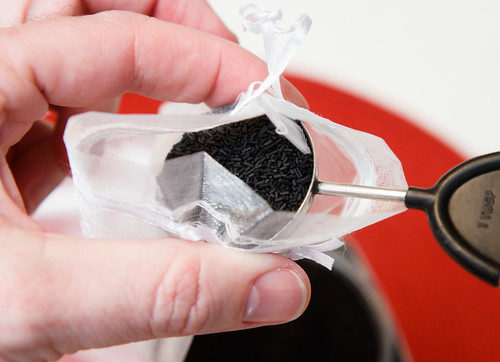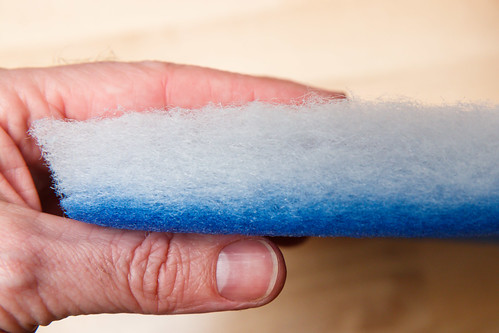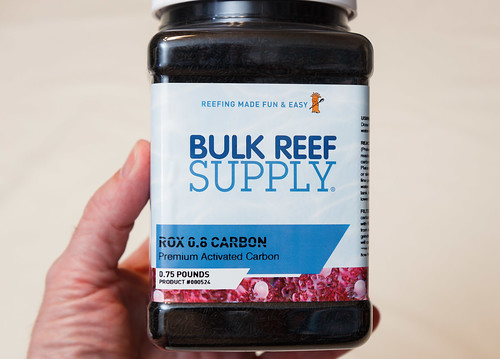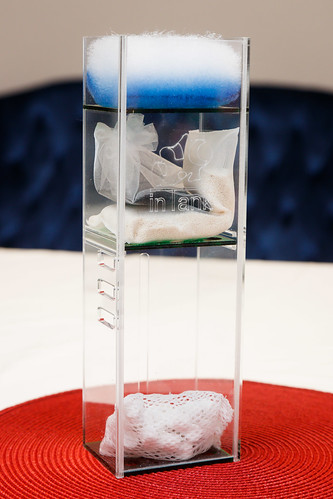One aspect of research for our new EVO nano aquarium got of hand real quick: filtration media options. For a number of reasons that I touched on in Part 1 and in the EVO 13.5 Review (and will reiterate below), I decided to immediately ditch the stock filter media that comes with the EVO 13.5 and find aftermarket alternatives.
Getting rid of the stock filter media leads to many questions of what should I use instead? I’ll use this space to speak on how I plan to manage filter media in the new EVO as well as discuss types of media you might need in a nano reef aquarium and when to use them. I expect this space to evolve as I learn and utilize these media options in the future.
Filtration Media Philosophies for Nano Reef Aquariums:
The information presented here is based on my research and seems to represent some prevailing philosophies in filtration media usage in a saltwater aquariums that I’d like to adopt:
Why the Stock Fluval EVO Filter Media Sucks:
For the EVO line of saltwater nano aquariums (both the EVO V and EVO 13.5), Fluval has stuck with the one-size-fits-all filter media: sponge block (with two cutouts), a bag of Biomax ceramic rings, and a bag of activated carbon.
First, the sponge. This is the sticking point for most people – it is said that over time that sponge media in a saltwater aquarium will become a ‘Nitrate Factory’. I’m not sure about factory, but I deduce the problem is that it becomes tedious to get all the trapped organics out of the sponge over time, and this could lead to excessive nitrates building up in a saltwater tank. The design has other issues that I discussed in the Spec V review, namely that water can bypass the cutouts for the media bags.
The media bags they provide (activated carbon and Ceramic) I actually don’t have a problem with for a saltwater tank. I’ve expressed that the activated carbon bags aren’t desirable, but that advice applies to freshwater and particularly, planted tanks.
Alternative Filter Media Arrangements for the Fluval EVO:
I’d say there are two options for replacing the stock EVO filtration system (with a filter media rack): DIY and the In-Tank Media baskets. The DIY option consists of making a filter media rack that slides into the filter section – Most people use egg crate light diffuser that you can get at the hardware store. You cut this into pieces and form into a cube shape (with an open top) and add shelves where you would like various media bags/media to rest. The pieces of egg crate can be secured together using zip ties. Maybe someday, I will make an instructional for this project.
For myself, I decided to go ahead and get InTank’s Chamber 1 Media Basket. It’s a bit pricy, but is very well made and works great to give me the freedom to manage filter media as I wish. I’ve got a full review of InTank’s Chamber 1 caddy here.
Filter Media – Keep em’ Separated:
Some saltwater media comes bundled with various categories of media all mixed together. An example of this is ChemiPure Blue, which comes in bags that contain both resin and carbon. It’s like a hybrid of Seachem Purigen and activated carbon together.
It seems convenient to get these together in one product; however, it leads to a few problems. First is that the media provided have different lifespans. The carbon contained within would need to be replaced about once a month. The resin could technically be reused and would surely last longer than a month. Since they come bundled together, you have to replace them both at the same time, thus wasting some of the lifespan of the resin.
Another issue with bundled filter media is that you can’t control the quantity. Perhaps you want to use a higher ratio of one over the other. With pre-mixed solutions, you can’t make any adjustments.
Purchase Filter Media in Bulk Packaging:
Many popular aquarium filter options come packaged either as bundled in sealed (mesh) bags or in bulk containers. It’s expected for those that purchase in bulk that the media will then be housed in a reactor or will be contained within media bags.
Stemming from some of the points above, I have a preference for purchasing media in bulk (loose) and packing into bags myself. The price/volume is much lower this way, and you have control over the exact quantity that you want to use.
Use Budget Filter Media Bags:
If you follow the advice above and purchase your media in bulk, you will need a bag of sorts to contain each inside your filter section. There are commercially available versions (one example, ‘The Bag’ from Seachem) made for the purpose, but they almost universally have issues with durability. The other issue is that even though these bags can be reused, they will wear out over time and potentially become so dirty you wouldn’t want to bother reusing (or trying to clean).
I love this tip that I got from a few reef forums. There is a source for mesh bags called Organza Gift Bags. They are super cheap (a fraction of the cost of aquarium specific products) – so cheap that there is no need to wash and re-use. I’m going to treat these as disposable. When the time comes to refresh the media in the bag, I will toss the whole thing and repack a new bag. These bags come in a variety of sizes, but generally speaking, they are smaller and are perfect for a nano reef.
To use, I just fill the bag with the media I’m using, tie off the top using the integral ribbon (using a double knot), and cut excess ribbon off.
The bags I link to above are 9 cm x 12 cm and are perfect for a nano. The mesh openings are fine enough to contain almost any filter media you will use (with a few exceptions that I will get into in a bit).
Categories of Filter Media Used in Saltwater Aquariums:
With some of these overarching ideas out of the way, let’s look at some broad categories of filter media that you might need in a saltwater nano along with some viable product options for each:
Mechanical Filtration:
Filter media in the mechanical category is the first line of defense for keeping your tank clean. I’d say it’s by far the most important and many people express that it is the only filter media that you absolutely have to have.
Mechanical filter options are often known as poly, poly pads, bonded filter pads, filter socks, etc. The concept is simple: they feature a fibrous construction (either woven or random) that captures impurities from the tank water. They rely on water flow through the media to capture excess organics floating in the water.
Mechanical filtration of this type is almost always placed so that water flows through this media before all other areas of a sump or filter section (in an All-In-One [AIO] tank like the EVO).
I have a strong preference for InTank’s Blue & White Poly Filter Floss. We started using this in our freshwater planted Spec V a few years ago and the improvement in water quality was dramatic. I like that it has multiple densities in one product – it catches a lot of junk!
Activated Carbon:
I seems that activated carbon is the second most popular and common filter media used in reef aquariums. Where mechanical filtration is used to trap the solid organics floating in your tank, some organic debris becomes dissolved into the water column. Beyond dissolved organics, toxin build up in any saltwater tank over time. The dissolved organics and toxins are part of what makes tank water turn yellow over time.
Activated carbon absorbs this category of impurities. It is relatively low cost and simple to maintain. Most guides that I see recommend changing out the activated carbon in your reef tank every month.
I decided to go with Bulk Reef Supplies brand of ROX 0.8 Activated Carbon. One common complaint with some brands of activated carbon is excessive dust clouding the water. BRS’s Rox 0.8 product doesn’t seem to have this issue. It has very small, but uniformly sized particles. I have noticed it takes almost no rinsing before the water runs clear from it. Also, even with the smaller particle size of this product, it stays in the organza bags I use. It is relatively expensive, but know that at the rate used in a nano tank, it will last a very long time.
Again, the bag of activated carbon that comes with any Fluval Spec or EVO aquarium is fine to use for this purpose. Once it is used up, I’d recommend going bulk to get a higher quality carbon and to save some money in the long run.
Resin Filter Media (Seachem Purigen):
This is a close cousin to activated carbon in purpose – It is used to capture dissolved organics. I’m making this a category but I only know of one stand alone candidate: Seachem Purigen.
Seachem Purigen is basically very small, resin balls. It is known for controlling build up of Nitrates, but what it is really doing is binding dissolved organics before they can break down to Ammonia > Nitrites > Nitrates.
I’ve used Purigen in our freshwater Spec V for years and I love it. I plan to use it in our EVO as well. The spheres that make up this product vary in size and are tiny – for this reason I’m not going to try to use it in the aforementioned organza bags. It is easy to purchase and use the 100ml bags – they fit fine in any Fluval EVO or Spec filter section.
A nice bonus of Purigen is that it can be regenerated (or cleaned). If you are willing to do this, it can make it very cost effective.
Bio-Filtration Media:
I discuss a bit in my fishless cycle page the concept of the nitrogen cycle, where bacteria colonies that live on surfaces in your tank form the basis of your aquarium’s filtration system. Since these bacteria only live on surfaces (and don’t just float in the water column), having adequate surface area in any aquarium is important. At some point, the capacity to process ammonia into nitrite, then to nitrate is limited by the surface area available in a tank.
It is for this reason that some reef keepers choose to add special filter media who’s sole purpose is to add surface area to the system. Fluval includes this type of media as stock with the bag of Biomax Bio Rings.
If I choose to add this type of filter media to a tank, I would use Seachem Matrix. It’s available in bulk and you could put as much as you wanted into your own bags.
Know that this category may be considered optional by many reefers. The sand and rock that is used in marine aquascaping adds much, and perhaps all, of the surface area needed to support biological filtration in your saltwater aquarium.
Phosphate Control Options:
An issue for Reef tanks as they approach maturity is accumulation of phosphates. High phosphate levels can upset some corals and it can be a cause for some types of algae.
A common filter media for removing phosphates is Granular Ferric Oxide, or GFO. An issue that I see with trying to use GFO in a nano reef, and especially an AIO tank, is that GFO typically is intended be ‘fluidized’ or tumbled to work. This typically happens in a reactor, which is a container that uses a dedicated pump to move the water internally and keep the filter media (contained within) afloat. I knew that a reactor would be a level of expense, complexity, and size that wouldn’t work with the AIO Evo.
An option that doesn’t require a reactor is Seachem Phosguard. It can be put in a bag and does not need to be tumbled – it can rest in a sump or in your filter media basket. It will help if you can place Seachem Phosguard in an area that gets flow. I will use the Phosguard option if I need to control phosphates in the future.
If I wanted to use a GFO type product, I would use RowaPhos. However, I don’t anticipate choosing to use this with the aforementioned need to keep this product tumbling and it is considered by some as too fine to be contained in media bags.
Initial Plan for Filter Media in Our EVO 13.5:
As I mentioned before, the only media you really need during the initial ‘cycling’ phase is the mechanical filter pad. However, I think I will go ahead and load it up with all the media that I plan on using for the start and near future. Filter media will be as follows:
- InTank’s Blue & White Poly Filter Floss: I will use this in the top section of the media basket. This will catch large solids first thing as they enter the filter section of the tank.
- Seachem Purigen (100ml bag): I will put this in the middle shelf of the media basket. It has to be folded in half to fit.
- Activated Carbon (BRS Rox 0.8): The dosage for the volume of this nano is 1 tablespoon. This goes in an organza bag and is placed on top of the Purigen bag.
- Fluval Biomax Bio Rings: I will toss the bag of ceramic rings that came with the EVO into the bottom of the media basket. It doesn’t have a lot of flow in this area of the filter compartment, but I feel like the extra surface area won’t hurt.
That’s it. I’d say the Biomax is optional and if I had to choose, I’d take the activated carbon over the Purigen, especially at tank startup.
It’s nice to have things decided on and situated in the filtration department. Next up is Part 6: How to Mix Saltwater for a Nano Aquarium.













Looks great! One question: you recommend activated carbon over the SeaChem Purigen in this setup, but you recommended replacing the activated carbon with SeaChem Purigen in your freshwater tank. Is this because activated carbon is better at trapping the toxins and organics in the saltwater tank, while SeaChem Purigen is better for a freshwater tank? Or is it because you don’t plan on dosing your saltwater tank with any fertilizer because you won’t have plants in there?
Thanks.
Great questions. Caveat – I’m learning. I can say that any comparisons between freshwater and saltwater is truly apples and cucumbers . . . they are totally different.
Yes – over 6 years with a planted freshwater, I’m confident activated carbon is not what you want. It removes the nitrogen fertilizers you are adding and strips what the plants need. Purigen is more of a direct cleaning product, reducing and trapping excess organics, but I don’t feel it truly competes to directly remove the fertilizers. Remember that in a planted tank, excess nitrates is a good thing as that is part of what feeds the plants.
In saltwater, this can be true to some extent – corals can feed on nitrates. It’s just that the biological load is higher and the balance in most tanks quickly results in nitrates that are too high (for the range deemed best for coral and tank health).
Thanks for learning along with me.
With saltwater, there i
This is an awesome article, just what I was looking for! Informative and great pictures.
Thanks! I’m a little behind in my writing for this series – thanks for the kind and motivating words.
Hi Nate, I found this article insightful, thanks for writting a blog on this! As I have setup my fluval 13.5 and now on week 7. Unlike you, I opted to use the stock filter for chamber 2 and nothing in chamber 1. I decided this as the stock has done no harm to my cycle and was on the knowledge for me that it was solely for initial setup. I used the activated carbon and media and recently changed the media to include Maxspect nano tech bio media. I have just ordered my chamber 1 media basket and plan on using what you have suggested for this fist chamber. what are your plans for chamber 2? I am thinking of using just the nano tech media for this as an extra filtration? but open to look at options and may look to buy a media basket for chamber 2 as my next step?
Full Disclosure: I’m a bit behind on writing; my tank has been going for about 6 months. I don’t see any reason to add filter media to the second chamber. I only have the heater in the second chamber.
I have started my first step into the marine world with the Fluval spec 13.5 (60ltr) tank, I have also been playing with different aftermarket media options. Can you tell me why you have done nothing in chamber 2, have you left the foam block there or are you planning on something else? Thanks
I have no need for anything in chamber two, other than the heater (in my case). There’s no need to cram every space with something if you don’t need to. The stock filter media (including the foam block) never got used.
I’ve watched how you done the Initial plan for filter media on Evo 13.5 for the first chamber, but I have the skimmer on the first chamber, so I’m going to put the filter media on second chamber. Does it follow the same order? Because it seams some of the water will flow in the middle and botom and if the poly filter is on the top section, some of the water will not pass trough it right? Can you please help me build the right order of filter media for chamber 2?
What are you putting the media in? If you are using the INTANK CHAMBER TWO MEDIA BASKET FOR FLUVAL EVO 13.5, they have a diagram on their site that shows where to put various media.
Newbie here. What I’ve been reading is that the order of filter media should be mechanical, then biological, then chemical. I have yet to find an article that explains why. Your thoughts? Thanks in advance.
Great question and I’m not sure it makes that much of a difference. I agree with having the mechanical first as it keeps the rest of your sump / filter section clean (and the other media clean – safeguard from clogging it up with detritus). Biological before chemical – I guess the thought is chemical could disrupt the bacteria in biological. I think those two can be interchanged in order as needed for your setup.